Cabbage Information II
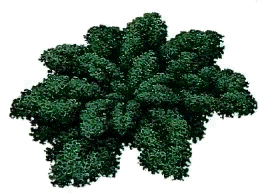
Kale
Brassica oleracea var. acephala
The kale is one of the oldest cropping vegetables in the world and may be similar to the ancestor of all modern cabbages. It has dark grey-green, deeply crinkled leaves. It thrives in cool climates and can reach 2.1 metres in height.
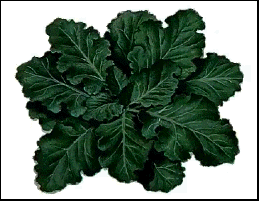
Collard
Brassica oleracea var. acephala
Also known as collard greens, the collard is a non-heading vegetable with dark grey-green crinkled leaves that is similar to kale. It is usually a biennial but may be a perennial in warm climates. It has a stout stalk of up to 60cm tall and is grown for its edible leaves.
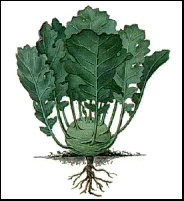
Kohlrabi
Brassica caulorapa var. gongylodes
The kohlrabi's major feature is its enlarged stem from which leaves develop. The kohlrabi is closely related to broccoli and brussels sprouts, but is not on first sight easily identifiable as a cabbage, looking more like a root vegetable. The kohlrabi may be white, green or purple in colour, and is native to Europe.
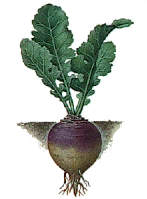
Rutabaga
Brassica napus var. neobrassica
The rutabaga is a biennial herb that is harvested annually for its smooth thick yellow or white root. It is similar in appearance to a cross between a cabbage and a white turnip. Rutabagas thrive in a cool climate and have a sweet flavour. They store well and grow slightly more slowly than other cabbages. They are thought to have originated in Europe in the Middle Ages, where they are still an important vegetable.
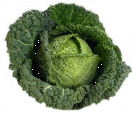
Savoy Cabbage
Brassica oleracea var. capitata
The savoy cabbage is similar in appearance to the drumhead but has distinctive crimped leaves of a blue-green colour. Its head is spherical and its leaves are less compact than those of the drumhead.
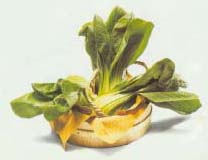
- Bok Choi (Chinese white cabbage, Chinese chard, pak choi, bok celery, celery mustard, white mustard cabbage)
Brassica rapa var. chinensis
The bok choi resembles chard or spinach and has broad tapering leaves. The leaves of the bok choi vary in length from 10cm to 30cm, and are green and rounded, mild flavoured and less crisp than other cabbages. The stalk of the bok choi is white. It is more closely related to swede and rape than to European cabbages.
- Pe Tsai (Chinese cabbage, napa cabbage, celery cabbage, hakusai, wong bok, Peking cabbage)
Brassica rapa var. pekinensis
The pe tsai has soft green veined ovate leaves and wavy-toothed leaves. Varieties include the wong bok and chihli and differ in colour, hairiness and tooth sharpness.
-
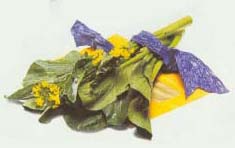 The Choi Sum (Chinese flowering cabbage, pak choi sum)
The Choi Sum (Chinese flowering cabbage, pak choi sum)
Brassica parachinensis
This cabbage has yellow flowers and green leaves with a mild mustard flavour. It is similar in appearance to the bok choi, but usually larger and with green stalks.
-
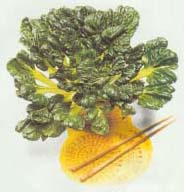 The Tat Soi (flat cabbage, tai goo choi, rosette pak choi)
The Tat Soi (flat cabbage, tai goo choi, rosette pak choi)
Brassica rosularis
The tat soi has dark green, rounded, shiny leaves with pale green stalks, and has a flavour similar to bok choi. The leaves are folded convexly and give the impression of a rosette.
Kerguelen Cabbage
Pringlea antiscorbutica
The Kergulelen (kur'-guh-lin) cabbage is not strictly a cabbage, although it belongs to the Cruciferae family and has a cabbage-like head that may be eaten as a cooked vegetable. It is grown on the Kerguelen and Crozet Islands in the Southern Indian ocean, where there are no flying insects to pollinate the plants, and so is adapted for wind-pollination.For more information, follow this link to the Kergulelen Cabbage Web Page
Cabbages in Name Only
- Cabbage Palm (Livistona australis ) - a tree that can grow up to 20m in height and inhabits marshes, pinelands and prairies. Its edible young leaf buds resemble cabbages, giving it its name.
- Cabbage Tree - Liliaceous Cordyline australis.
- The Skunk Cabbage - a strong smelling herbaceous plant that grows in wet areas of Eastern North America. It appears in early spring as a clump of large, broad and veiny leaves and has an odour similar to that of a skunk.
- Warrigal Cabbage (Tetragonia expansa) - a plant better known as New Zealand Spinach in the Ficoidacae family.
Cabbage Information Page 1


 The Choi Sum (Chinese flowering cabbage, pak choi sum)
The Choi Sum (Chinese flowering cabbage, pak choi sum) The Tat Soi (flat cabbage, tai goo choi, rosette pak choi)
The Tat Soi (flat cabbage, tai goo choi, rosette pak choi) 




